Every options trader should know what options spreads are and what different types of options spreads exist. If you aren’t completely familiar with options spreads, this article will definitely help you out! After reading this article, you won’t only know what an options spread is. You will also be familiarized with all the different options spreads that exist. This is very powerful because if you fully understand options spreads, you will understand ALL options strategies!
So without further ado, let’s get started.
What Is An Option Spread?
Before we get into the different kinds of options spreads that exist, it is important to understand what an options spread even is. So what is an option spread?
An options spread is an option strategy involving the purchase and sale of options at different strike prices and/or different expiration dates on one underlying asset. An options spread consists of one type of option only. This means that options spreads either solely consist of call or put options, not both. Furthermore, an options spread has the same number of long as short options.
Let me give you a concrete example to make it clear what an options spread is. The following position is an options spread:
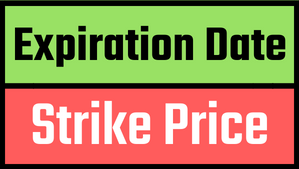
- 1 XYZ short call with a strike price of 100 that expires in 40 days.
- 1 XYZ long call with a strike price of 105 that expires in 40 days.
As you can see, the just-described options only differ in regards to strike price and opening transaction (one call option is bought and the other one is sold).
Let’s recap the characteristics of an options spread:
- All involved options are on the same underlying asset (e.g. XYZ).
- All involved options are of the same type (call or put).
- An options spread always consists of the same number of purchased as sold options (e.g. 5 short and 5 long).
In other words, the options involved in an options spread only differ in regards to strike price and/or expiration date. This is the case for all options spreads, regardless of kind. So when I will walk you through all the different options spreads in a few moments, keep this in mind.
Even though the options involved in an options spread only differ in regards to 1-2 aspects, it is still possible to create a wide variety of different options spreads.
Next up, I will walk you through all the different kinds of options spreads: vertical spreads, horizontal spreads, diagonal spreads, credit spreads, debit spreads, bull spreads…
Option Spreads Visually Explained
Watch the following video for a visual breakdown of option spreads:
Different types of options spreads explained
What are vertical spreads?
Vertical spreads are options spreads created with options that only differ in regards to strike price. So basically, a vertical spread consists of the same number of short calls as long calls or the same number of long puts as short puts with the same expiration date (on the same underlying asset).
This doesn’t leave too many possibilities. That is also why only four different vertical spreads exist, namely bull call spreads, bear call spreads, bull put spreads and bear put spreads.
These four different vertical spreads can be ordered into different categories:
- Bull Spreads: Bullish spreads (that profit from increases in the underlying asset’s price).
- Bear Spreads: Bearish spreads (that profit from decreases in the underlying asset’s price).
- Call Spreads: Spreads that consist of call options only.
- Put Spreads: Spreads that consist of put options only.
- Credit Spreads: Spreads that are opened for a credit (you get paid to open).
- Debit Spreads: Spreads that are opened for a debit (you pay to open).
A bull call spread is a bullish debit spread, whereas a bear call spread is a bearish credit spread. A bull put spread is a bullish credit spread and a bear put spread is a bearish debit spread.
Here is how the four different vertical spreads are set up:
Bull Call Spread (aka. Long Call Spread):
- 1 long call
- 1 short call at a higher strike price (with the same expiration date)
Bear Call Spread (aka. Short Call Spread):
- 1 short call
- 1 long call at a higher strike price (with the same expiration date)
Bull Put Spread (aka. Short Put Spread):
- 1 long put
- 1 short put at a higher strike price (with the same expiration date)
Bear Put Spread (aka. Long Put Spread):
- 1 short put
- 1 long put at a higher strike price (with the same expiration date)
All vertical spreads are defined risk and defined profit strategies which means that you can’t lose or profit more than a certain amount. The amount of risk and potential profit depends on the width of the strikes and on the position of the strikes in relation to the underlying’s price.
To calculate the max risk and max profit of vertical spreads, you need one calculation:
Width of Strikes × 100 − Net Credit or Debit
This calculation reveals the max risk of credit spreads (Bull Put Spreads and Bear Call Spreads) and the max profit of debit spreads (Bear Put Spreads and Bull Call Spreads).
The max profit of credit spreads equals the net credit collected to open, whereas the max risk of debit spreads equals the net debit paid to open.
Vertical spreads are directional strategies which means that they mainly profit from price movement in the underlying asset’s price. That’s also why they are called bull/bear spreads. This means that vertical spreads are a strategy principally used to take advantage of price movement. Nevertheless, implied volatility and time still can influence vertical spreads to a certain extent.
What are horizontal spreads?
Horizontal spreads are options strategies that consist of the same number of long as short options that only differ in regards to the expiration date (on the same underlying asset). In other words, the options involved have the same strike price but a different expiration date.
Let me give you a concrete example to explain what a horizontal spread is:
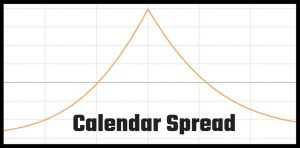
- 1 long ABC call with a strike price of 50 that expires in 29 days (front-month).
- 1 short ABC call with a strike price of 50 that expires in 57 days (back-month).
Just like with vertical spreads, there only exist four different kinds of horizontal spreads, namely short call calendar spreads, long call calendar spreads, short put calendar spreads and long put calendar spreads. As you may have noticed, all of these spreads are calendar spreads. That is also the reason why horizontal spreads also are referred to as calendar spreads.
The setup of these four different calendar spreads is relatively simple:
Long Call Calendar Spread:
- 1 short call (front-month)
- 1 long call at the same strike price (back-month)
Short Call Calendar Spread:
- 1 long call (front-month)
- 1 short call at the same strike price (back-month)
Long Put Calendar Spread:
- 1 short put (front-month)
- 1 long put at the same strike price (back-month)
Short Put Calendar Spread:
- 1 long put (front-month)
- 1 short put at the same strike price (back-month)
Calendar spreads are mainly used as a strategy to profit from changes in implied volatility and from time decay. For instance, long calendar spreads profit from increases in implied volatility.
Generally, calendar spreads aren’t a very directional strategy. But depending on the strike selection, calendar spreads can be set up more and less directional.
What are diagonal spreads?
Diagonal spreads are a combination of vertical and horizontal spreads. A diagonal spread is a strategy that consists of the same number of long as short options that have different strike prices and different expiration dates.
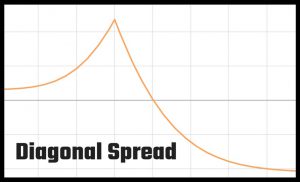
The options used in vertical spreads only differ in regards to strike price, the options used in horizontal spreads only differ in regards to the expiration date and the options used in diagonal spreads differ in regards to both strike price and the expiration date.
There are many different ways to set up diagonal spreads. But here are a few concrete examples of possible diagonal spreads.
Diagonal spread example 1:
- 1 short XYZ call with a strike price of 185 that expires in 27 days (front-month).
- 1 long XYZ call with a strike price of 190 that expires in 55 days (back-month).
Diagonal spread example 2:
- 1 long ABC put with a strike price of 78 that expires in 20 days (front-month).
- 1 short ABC put with a strike price of 72 that expires in 48 days (back-month).
Just like I said before, diagonal spreads are a combination of vertical and horizontal spreads. This means that they try to profit from changes in both the underlying asset’s price and implied volatility/time. Diagonal spreads can be slightly to very directional strategies.
Recap – Options Spreads Explained
It is very important to understand what an options spread is and what different kinds of spreads exist. That’s why I want to recap some of the most important points of this article.
I created the following table to visually explain the different options spreads. Furthermore, this table actually reveals why the different spreads are called the way that they are (horizontal, vertical, diagonal).
Download this table for future reference.
Now you should know what different spreads exist. But you might ask yourself the question, which of these spreads is best.
There is no one right answer to this question. Not one spread is better than another. It really depends on the current market situation and on personal preferences. For instance, if you are bullish on a stock and want to take advantage of an up-move, a bull call vertical spread might be a good strategy. However, if you want to profit from a rise in implied volatility and don’t have a certain directional assumption, a horizontal/calendar spread would probably be a better choice…
I hope you understand what I am trying to say.
But generally speaking, vertical spreads are the simplest of the three. Horizontal and especially diagonal spreads are much more complex due to the different expiration dates of the different options. Therefore, I wouldn’t necessarily recommend trading (horizontal or) diagonal spreads if you aren’t completely familiar with them.
In the introduction, I mentioned that if you fully understand options spreads, you will understand all options strategies. But why do I think this?
The reason why I am saying this is that options spreads are the building blocks of almost all other options strategies. If you combine multiple options spreads, you can create almost any strategy. So instead of trying to understand how these dozens of different strategies work, it is much more efficient to learn how the building blocks of these strategies work.
Let me give you a few examples:
You probably realized that vertical spreads are relatively simple (compared to other options strategies). They are a two-leg strategy that consists of a long call and short call or a long put and short put.
But what happens if we combine multiple vertical spreads?
A new strategy is born! There are four different vertical spreads that can be combined to create a new strategy. I will now give you some concrete examples of what happens when you combine multiple vertical spreads.
Iron Condor
You may or may not know the option strategy iron condors. It is a very good and popular four-leg options strategy. Due to its four legs, it is usually labeled as an ‘advanced’ options strategy. But in reality, it isn’t anything else than a combination of two simple credit spreads.
I created the following image to explain this concept visually.

Hopefully, you can see how a combination of a bear call spread and a bull put spread create an iron condor.
Butterflies
Now let me give you another concrete example. Butterflies are another options strategy often referred to as complex and thus, only suitable for ‘advanced’ traders. But just like with iron condors, butterflies aren’t very complicated either. They are simply a combination of a bear call spread and a bull call spread.

Hopefully, these two examples make it clear how options spreads are the building blocks of most options strategies. These were just two of many examples where this is the case.
So in conclusion, options spreads can be thought of as Lego bricks. Just like Legos, options spreads can be combined in many different ways to create whatever your heart desires.
If you want to learn more about options strategies and when to use which strategies, you might want to check out my free strategy selection handbook.
My goal with this article was to introduce you to options spreads and thereby build a stable foundation for options trading strategies. It would be awesome of you to let me know if I achieved this goal in the comment section below!
Furthermore, if you have any questions, feedback or other comments, please tell me in the comment section.

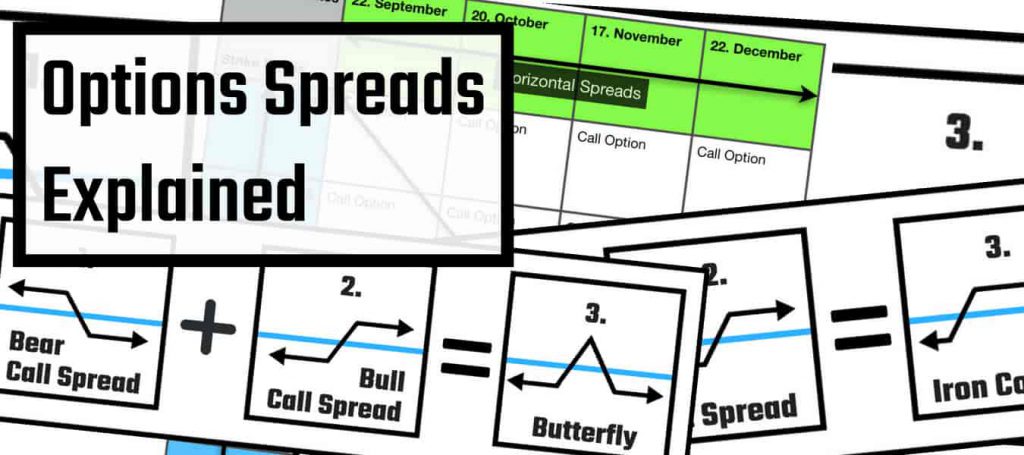

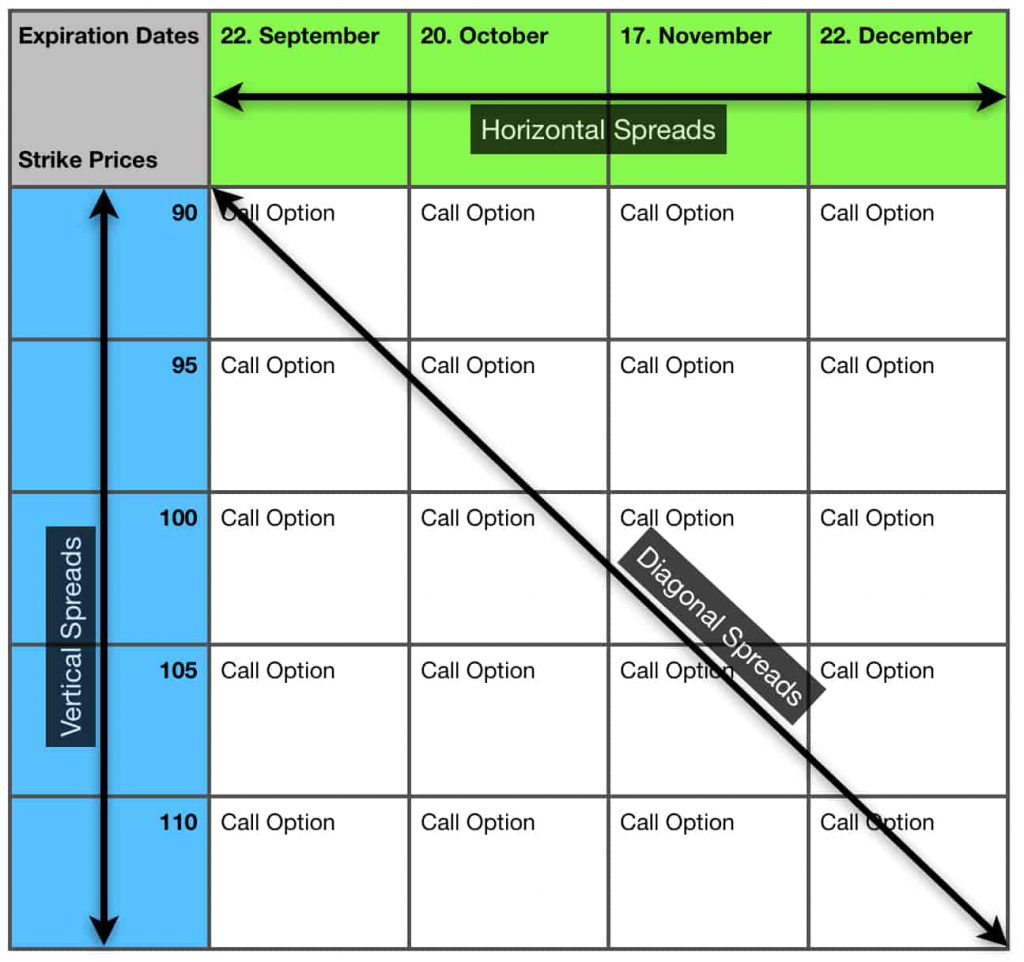
Your explanation of the Option Spreads as building blocks to other strategies makes sense, but I am confused by the Iron Condor and Butterfly.
Does the Iron Condor and Butterfly make you money if the underlying asset price does not go over a certain amount or go over and then come back down before expiration?
That’s kind of what it looks like from looking at the graphs you included.
Hi Alexander,
Thanks for your question. Iron condors and butterflies profit if the underlying asset’s price stays in a certain range. The size of this range depends on the strikes selected and the premium received/paid. I hope this helps with clarifying the confusion.
Otherwise, you could check out my article on Iron Condors and Butterflies.
Reading through this very comprehensive article on Option Spreads in Trading was so interesting. For someone new to this world of Trading it would need to be gone through a few times to fully understand all the terminology and nuances of trading. It is really complex for an ordinary person not versed in doing anything like this previously.
To my mind, if you are ready to Trade, you would need to be aware of the risks involved and not be afraid of losses. Only Trade with the amount you can afford, would be my way of thinking. Perhaps am too conservative.
It was very interesting to learn something new. Will take a look at it again at a later stage.
Thanks for the comment Jill. It is completely normal for people new to the world of trading to have trouble understanding everything. That’s actually also why I created a free trading terminology handbook in which you can look up all the seemingly complicated trading terms. So judging from your comment, you could definitely use my free trading glossary.
And no you are not too conservative! You should never risk more than you can afford to lose.
Hi Louis, I have completed your education classes and they are good, and I have learnt a lot. Best of all, I have learnt more from your free education than all the other programs I have paid for. Be leave me I have spent a lot of money on paid sites and it is not worth it. Selling short term options is my goal. However, I am have trouble comprehending receiving a credit when I sell an option. When I sell an option for a credit, I only receive the credit if it expires worthless Right. Thanks for your help
Hi Tom,
Thanks for the question. I hope I can clarify your confusion. When you sell an option to open a position, you receive a credit. So now you have a negative position open. To close this position, you could either buy back the sold option or wait until expiration. If you buy it back, you will give up some of the received credit. The amount of credit that you give back depends on the option’s price. If it has gone up, you might even have to pay more to close the position than you received when opening it.
If at expiration, the underlying’s price is at the right point, the option might expire worthless and only then, you could keep the entire credit that you collected when putting on the position.
Let me give you a concrete example:
You sell a call option with a strike price of $105 on XYZ which is trading at $100. You receive a credit of $1,50 (so $150). But now you have an open position which has to be closed for you to lock in the profit. As long as the position is open, the profits (or losses) are purely paper profits (or losses). They are only realized if you close the position which you can do by buying back the call option or by waiting until the expiration date.
Let’s say, you buy back the call option for $0,7 two weeks later. This would mean that you have a realized profit of $1,5 – $0,7 = $0,8 (or $80). So you can keep $80 of the collected credit.
If you instead wait until expiration and XYZ’s price is still below $105, you can keep the entire $150 of credit.
I really hope this helps. If you have any other follow-up questions, let me know.
Hi Louis,
In your reply to Tom looks like you did not mention that at expirations time if the stock price is above the strike price in a short call or below the strike price in short put, he would be forced to buy the stock at the strike price.
Thanks for the comment. Usually, when a trade such as a short call or short put is ITM shortly before expiration, I recommend closing the position for a loss. If you do this, you won’t have to buy or sell any shares at the strike price. I never recommend holding a losing short option position into expiration (unless you want to buy or sell stock at the strike price).
But you are right that if you would hold such a position into expiration, you would have to buy/sell stock at the strike price.
since a call spread would probably be assigned if the stock price goes above the strike price, it seems to me that it would be better to use a put spread when one expects the stock to go up and a call spread when one expects it to go down. Opposite of single options.
Hi and thanks for your comment,
I wouldn’t use assignment risk as a main factor when choosing which strategy to go for. Instead, I recommend looking at different market variables such as implied volatility, time till expiration, underlying asset, and price. Depending on the situation and your market assumption, a bull put spread can be better than a bull call spread and vice versa. The same goes for bear spreads. It depends on the situation.
thank you so much. i’m already tied to a service my brother uses and i’ve looked for definitions so i could understand what i’m doing. this is the first site that actually deals with information and it’s great. hopefully i can get back as a trader.
I learned a lot from your presentation. Thank you very much!